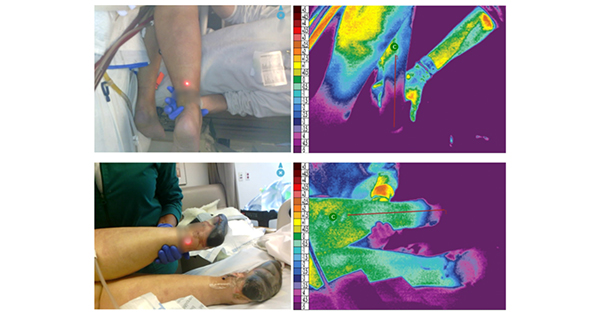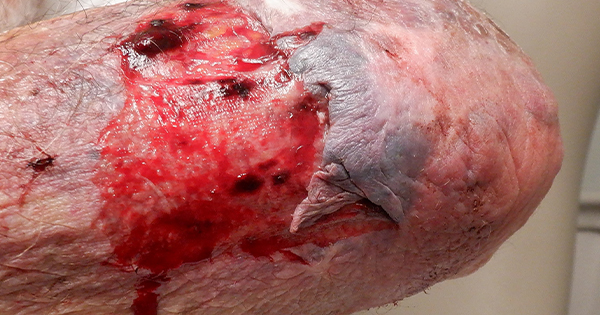Although accurate data on the global prevalence of wounds are limited (Martinengo et al, 2019), epidemiological data suggest that chronic wounds are increasing over time as life expectancy increases (Gupta et al, 2021). The burden of wounds is disproportionate in resource limited communities, and patterns of wounding are different to that seen in high resource countries.
First, the epidemic of health conditions that contribute to chronic wounds in high resource Western communities is also dramatically increasing in resource limited settings. Diseases such as diabetes, venous insufficiency, peripheral vascular disease and obesity have significantly increased across Asia, Africa and South America (Gupta et al, 2021), leading to a dramatic rise in the prevalence of diabetic foot ulcer (Yi et al, 2019) venous leg ulcers (Shrinivas, 2017) and pressure ulcer (Chauhan et al, 2005; Anthony et al, 2021).
In addition, acute wounds occur from causes seen less often in high resource countries. Acute wounds from agricultural accidents, burns, animal bites, road trauma, armed conflict and natural disasters are commonly observed in resource-limited settings (Builders and Builders, 2016; Ryan, 2020; Toppino et al, 2022; Ogundeji et al, 2022; World Health Organization (WHO) 2018; 2022). The burden of wounding and skin lesions is further exacerbated and complicated by bacterial and viral diseases that are seen more commonly in limited resource settings (particularly tropical regions), for example, rabies (WHO, 2023a), buruli ulcer (WHO, 2023b; Vuagnat and Asiedu, 2020); lymphatic filariasis (Haesler, 2015a; 2015b; Toppino et al, 2022) and Hansen’s disease (Lehman and Vuagnat, 2020).
Reliable data on the prevalence and incidence of both chronic and acute wounds in resource-limited settings are lacking and urgently needed (Martinengo et al, 2019). Existing published prevalence or incidence rates are either outdated or limited to regional data. A recent wound surveillance survey found a wound prevalence of 13% in households in a region of western Africa (Toppino et al, 2022). In India, a door-to-door survey indicated the prevalence of chronic wounds at 4.48 per 1,000 population and prevalence of acute wounds at 10.55 per 1,000 population (Gupta et al, 2004).
Despite the high burden of both chronic and acute wounds in resource-limited communities (Macdonald et al, 2010; Gupta et al, 2021), these countries experience significant disadvantage with respect to wound prevention and treatment due to factors that both lead to and exacerbate a reduced ability to achieve positive wound outcomes. This includes having more isolated/remote regions with limited health services, limited supply of physical resources, lower health literacy, fewer skilled wound practitioners and a lack of schemes that assist in financing healthcare, such as government funding or health insurance (Builders and Builders, 2016; Ryan, 2020; Gupta et al, 2021; Ogundeji et al, 2022).
Reduced resourcing extends to contemporary wound dressings and topical treatments. Moist wound dressings, such as hydrocolloids, foams, hydrofibres and hydrogels, that were recently referred to as ‘advanced’ are now considered standard treatment in most Western countries. However, in low resource settings these products are harder to access, cost more and, when accessible, practitioners delivering wound care do not always have the training to use the products to the best advantage (Builders and Builders, 2016).
In resource-limited settings, natural products that have been used for centuries for treating skin problems and wounds are still successfully used as wound treatments. Many of these traditional treatments are botanical-based and take advantage of the natural qualities of locally available resources, such as fruits, herbs and leaves (Builders and Builders, 2016; Haesler et al, 2016). Local botanical products are used in wound care to achieve the same principles of local wound healing that are applied in Western countries: debridement, infection and inflammation control and moist wound healing. Essentially, botanicals and other local resources are used for their qualities that are important in wound management, including their ability to donate or absorb moisture; astringent characteristics that debride; ability to manage wound temperature and odour, natural antibacterial, anti-inflammatory and anaesthetic qualities or simple protective ability (Haesler et al, 2016).
Regardless of their accessibility, it is important that practitioners ensure the products they use in wound prevention and treatment are effective in achieving positive clinical outcomes. Use of products that have no clinical benefit for the wound or patient can extend the time the wound takes to heal, increase the risk of complications or adverse effects (e.g., wound infection or pain), delay the use of a more effective products and/or waste a resource that may be used more with more effect for another patient or purpose. Reviewing the clinical evidence for local resource wound treatments assists wound practitioners in low-resource settings to make informed clinical decisions.
Evidence summary methodology
The Wound Healing and Management (WHAM) Collaborative undertakes evidence syntheses to provide overviews of the clinical evidence for local resource wound treatments. WHAM evidence summaries are produced and disseminated to assist wound practitioners in low-resource settings to evaluate the efficacy and safety of wound treatments available in their geographic region and make informed decisions when implementing their wound care (Haesler et al, 2016).
The low-resource evidence summary initiative commenced in 2012, in response to local wound practitioners and staff and students on exchange programs in resource limited countries identifying a need for documented evidence on the effectiveness of natural/traditional products in common use.
WHAM evidence summaries are rapid evidence reviews, produced using methodology published by the Joanna Briggs Institute (Joanna Briggs Institute, 2013a; 2013b; 2014; Munn et al, 2015; Aromataris and Munn, 2020). Each evidence summary addresses a specific clinical question on the effectiveness and safety of a local resource wound treatment, drawn from a taxonomy of different treatments that are suggested to the WHAM Collaborative by practitioners using the products, and by the Collaborative’s international peer review panel. A systematic literature search is conducted in healthcare databases, including Medline, Cumulative Index to Nursing and Allied Health Literature (CINAHL), EMBASE, the Cochrane and JBI libraries, and the Allied and Complementary Medicine Database (AMED). To target local resource treatments, a search is also conducted in the WHO Health InterNetwork Access to Research Initiative (HINARI) database (WHO, 2023c), and supplementary searches are conducted in Google Scholar. Searches use Medical Subject Headings (MESH) and key terms related to the specific treatment of interest. No publication date restriction is used, but searches are restricted to publication in English language.
Identified literature is assigned a level of evidence based on the hierarchy developed by JBI (Joanna Briggs Institute, 2013; 2014; Munn et al, 2015). While gold standard, evidence-based practice is based on the highest Level 1 evidence from meta-analyses, systematic reviews and randomised controlled trials (RCTs), the JBI evidence hierarchy recognises the contribution of other types of evidence to clinical practice (Joanna Briggs Institute, 2013; 2014; Munn et al, 2015). The hierarchy includes studies without control groups, case studies and qualitative evidence, which account for much of the available published evidence for local resource interventions used in limited resource settings. Identified evidence is appraised using JBI risk of bias tools.
Data on the effectiveness of the intervention on the outcomes of interest are extracted and tabulated in the evidence summary. Based on the benefit-to-risk profile, risk of bias of the evidence, resource impact and the likely values of patients with wounds, a clearly stated recommendation for clinical practice is made, and assigned a JBI Grade of Recommendation (Joanna Briggs Institute, 2013a; 2014; Aromataris and Munn, 2020). Finally, considerations to the way in which the treatment is prepared and administered, cultural acceptability, transferability and adaptability of the wound treatment, cost-effectiveness, and positive and negative patient and practitioner experiences associated with its use are provided to assist implementation of the recommendation.
Evidence summaries are reviewed by an international panel of 19 wound experts before publication in both peer reviewed journals and on the WHAM Collaborative website (http://www.WHAMwounds.com).
Evidence summary recommendations
The WHAM Collaborative has produced evidence summaries for 20 treatments commonly used to treat wounds or skin conditions in limited resource settings. Table 1 provides an overview of these treatments and the recommendation for their use in achieving different clinical outcomes. Many traditional local resources are used for their antibacterial properties. Sufficient evidence is published to make a strong recommendation for 1–3% acetic acid (Watts, 2015) and cadexomer iodine (WHAM, 2014) to manage wound infection. A weak recommendation was made for the use of 3% citric acid (Watts and Frehner, 2016), traditional hypochlorite solutions (Haesler and Carville, 2023), honey (Watts and Frehner, 2017), polyhexamethylene biguanide (PHMB)(WHAM, 2020) and povidone iodine (WHAM, 2014) to reduce signs and symptoms of wound infection. Although commonly used as an antibacterial treatment, there was insufficient published evidence on tea tree oil (Haesler and Carville, 2021); however, a weak recommendation is made for its use in managing wound odour. Honey (Watts and Frehner, 2017) and green tea (WHAM, 2013) were similarly recommended to manage malodourous wounds. There is evidence on which to make a weak recommendation for using the following products to improve wound/skin healing: aloe vera (Haesler, 2017; 2022a), banana leaf dressing (WHAM, 2017b), 3% citric acid (Watts and Frehner, 2016), coconut oil (Watts et al, 2021), honey (Watts and Frehner, 2017), PHMB (WHAM, 2020), potato peel dressing (Haesler et al, 2017) and oral turmeric (Haesler, 2022b).
Despite the many topical coconut-based products available for medicinal purposes in tropical areas, no published evidence was available on its effectiveness in promoting healing or managing wound signs and symptoms; however, there was sufficient evidence to make a weak recommendation for its use in managing xerosis (Watts et al, 2021). Turmeric is often applied topically to manage wound infection and inflammation, but there is insufficient published evidence to make a recommendation (WHAM, 2017a; Haesler, 2022c). Although commonly used as a debriding agent, there was insufficient published evidence to recommend papaya-based products for wound healing (Watts and Solomons, 2021).
Most recommendations for local resource wound treatments are weak. This indicates that although the desirable effects appear to outweigh undesirable effects, this is not sufficiently clear from the available evidence, and/or the available evidence is at risk of bias (Joanna Briggs Institute, 2013). This reflects that in general the research available to support local treatments is less rigorous and/or uses lower level study designs. There is an urgent need for rigorous research into interventions used in limited resource settings to increase the evidence base and understanding of both the benefits of these treatment options and any risks associated with their use.
It is important to acknowledge a significant limitation to WHAM low resource evidence summaries. Many local wound treatments are traditional, and their use is passed on between health practitioners and through generations verbally and via demonstration. Publication of formal research is often not prioritised and/or accessible in the English language.
Conclusion
Access to evidence increases knowledge, clinical options, and safe wound practice. Rapid evidence summaries provide a synthesised source of evidence, presented in an easily digestible format to assist wound practitioners to effectively implement clinical decisions with consideration to locally available resources. Although the treatments used in limited resource settings often vary considerably from standard Western wound treatments, the same principles of wound management are promoted by local treatments, including debridement, infection and inflammation control, and promotion of moisture balance. Additionally, by providing a comprehensive overview of the current published evidence base, evidence summaries assist in identifying future research needs and opportunities.






